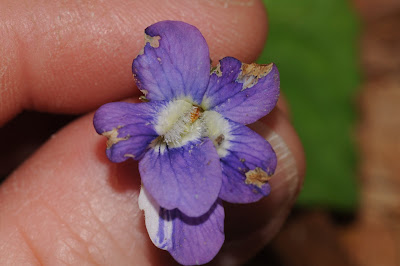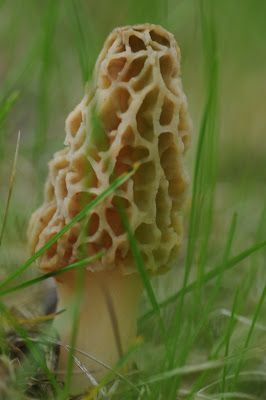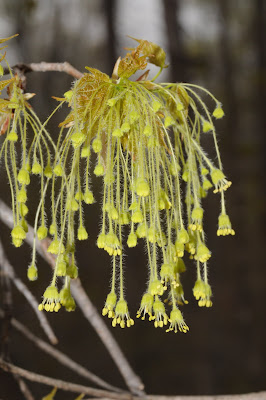You'd think that with a big ol' sign like this that the entrance would be easily spotted (Easudes Road), but I drove right by it without seeing it at all. When I turned around and headed back, I watched the odometer (about 1 miles west of Sharon Hollow Rd., on the left), and there it was. No driveway, and barely a parking area - it's no wonder I missed it on my first pass.
I immediately found flowers to photograph.
This is one of the baneberries, but I'm unsure which (didn't bring my field guide with me,
and inevitably, the photograph doesn't show the part(s) one needs for accurate ID).
Red baneberry's flower raceme is usually about as wide as it is long, whereas
the raceme on the white baneberry is usually longer than wide and each
individual flower stalk is rather stocky. If I had to make a guess, I'd say this is red.
The obvious star of the day was the mayapple, which was growing
in great profusion and at the peak of its flowering.
Some of the blossoms were over two inches across - simply enormous!
White trillium carpeted what seemed like every acre of the forest in this 250+ acre parcel
of land. the majority of the blooms were well past their prime, but even in their decline,
they were impressive simply because of their numbers.
As one leaves the first stretch of woodland, one crosses a powerline easement.
The path is well-worn, an indication of how well-used it is.
A variegated violet with a furry throat.
Sarsaparilla was starting to flower. Most of these plants have three balls
of flowers, but I found one this day that had four.
As they age, white trilliums turn pink. Most today were quite pink, but
one or two white ones were still hanging on.
One of the great features of this preserve are is the fantastic set of boardwalks
and bridges. These are well-built and pretty well-cared for.
I've gotten the impression from Michiganders with whom I've spoken that
Beech Scale Necrosis has not struck here in Michigan. No one here seems
to appreciate what a treasure they have in their American beech trees.
Not a single one, even the ones that have fallen down, has been hit
by this awful disease, a combination of an invasive scale insect and a native
nectria fungus. I haven't seen such beautifully pristine beech trees
since I was a kid, back in the '70s and early '80s.
Maidenhair ferns were nearly as prolific as the mayapples.
Adding a welcome splash of color to the lush green and white landscape was
golden ragwort. This knee-high plant apparently likes to have its feet wet,
for every soggy area along the trail sported patches of floral sunshine.
These ants were terribly focused on the remains of a caterpillar they discovered.
a stem or two of this delicate plant, but here there were lots and lots
at the peak of their blooming.
This pair of white violets are a conundrum. They look very different - the one above
with petals spread out and the one below with a very furry throat
and sort of recurved petals.
And yet, they were seeming growing together on the same plant (see below). Logic dictates that they are two separate species, just living cheek by jowl with each other. I await species confirmation from my violet expert friend, Jackie.
There were plenty of insect finds today, although most, like the tiger and spicebush butterflies, did not sit still long enough for me to photograph them. Still, I found lovely examples of a leaf roller (above) and tent caterpillars (below)
Solomon's plume (aka: false Solomon's seal)
was only juuuuust starting to blossom.
I was too late for the squirrel corn and Dutchman's breeches.
Next year.
I had originally thought that this was one of the baneberries, but
upon consultation with Newcomb's I discovered I was wrong.
In my attempt to key it out, I kept ending up on the toothworts,
but I'm not buying it. Suggestions welcome!
A sea of mayapples.
There were lots of wild geraniums in bloom,
and plenty of the wild blue phlox.
Thanks to the plentiful rain this spring, the woodland vernal pools
were all quite full. Mosquitoes have begun to hatch.
There are two trail loops at Nan Weston. The one I took had a spur that
went to the Mill Pond. It's the most river-like "mill pond" I've ever seen!
A loud rustle and flapping of wings startled me from this tree across the water.
I watched as a turkey vulture flew away. Before long, however, it returned.
Could there be a nest here? I stuck around and waited.
Before long, it flew out again. It didn't go far, soaring around above
the canopy. Because the weather was starting to get iffy, I didn't stick
around to see if it returned to the tree, but I suspect it did.
Two more spots of bright color were the orange fungi (above) and
lovely red oak leaves (below). How nice that not quite everything in the
spring is green.
I returned to my car just as the first raindrops started to fall. Several storm cells went by the rest of the afternoon, dropping at least another inch of rain. And as I sit here now, typing up this post, a severe thunderstorm is rolling overhead. The sky has been nearly as dark as it is at 9:30 PM, and the thunder has been rolling steadily for the last hour and a half. Yes, it's been a very wet spring, but the spring flowers certainly seem to be enjoying it.







































































